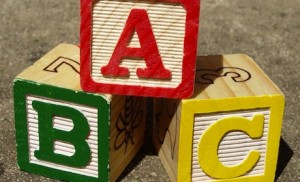All kids learn the cute little song, but that doesn’t mean they know the alphabet! There are at least six other things your preschooler needs to know about those 26 letters before thinking about reading.
1. The letters have shapes. Reading is a visual activity, so it is essential that your child begins to recognize the shapes of letters. You can buy plastic or wooden letters in a variety of sizes (be aware of choking hazards) and make a game out of recognition. You can point out and talk about curved letters, straight letters, dotted letters, tall letters and short letters. Help your child use visual cues and references: “M” looks like mountains, “W” is reaching up to catch the water and “J” looks like a fishing hook, etc.
2. The letters have a sequence. Alphabet puzzles are helpful for this skill. Reciting the alphabet while placing the letters in a row is also good. You might want to trace letters onto a mat to use for matching activities. Make up stories about the letters wanting to change places, or pretend the alphabet is a train. Create a timed game: mix up the alphabet letters and give your child a prize if he can put them in order in two or three minutes.
3. The letters are finite. There are only 26 letters in the alphabet. That’s amazing when you think of how many words we have in our language. It’s important for your child to understand that the alphabet doesn’t change. This concept makes the whole idea of “learning the alphabet” seem much easier.
4. The letters represent sounds. You don’t have to get into a discussion of long and short vowel sounds with your preschooler. However, you should help your child hear the letters at the beginning or end of words. “What letter do you hear at the beginning of your name?” or “What letter does cat start with?” are questions your child can begin to answer. You can read books or use flash cards that encourage your child to make associations such as “A is for apple.” Do not teach the specific sounds of each letter unless you have training in phonics.
5. The letters follow rules. You can make this educational and entertaining. Letters do not get to “stand on their heads” or “walk backwards.” They are not allowed to trade places with each other. They are not allowed to make another letter’s sound unless they have permission (s/c, c/k, etc. have permission). They must cooperate to make most words. Make up a story about why “A” and “I” like to work alone.
6. The letters are used together to form words. There are lots of ways to teach this skill. One of my favorites is the “word family” concept. You can use plastic letters, letter cards, or paper and crayons for this game. Form or write a two-letter word ending such as “og,” “ig,” “op,” “at,” “ot” or “ar.” Then help your child form words by adding one beginning letter. “Og” can become bog, dog, fog, hog, jog or log. “At” can become bat, cat, fat, hat, mat, pat, rat, sat, tat or vat. As your child gets older and more adept at spelling, you can also take six to eight letters that you know will form some words and mix them up. Then let your child make words and say them for you.
Reading is an essential lifeskill. If parents and teachers work together we can reach the goal of raising confident readers. Let’s make it happen.
Mary E. Maurer is an elementary teacher with a master‘s degree in education. Mary and her husband, Gary, have three children and three grandchildren.





